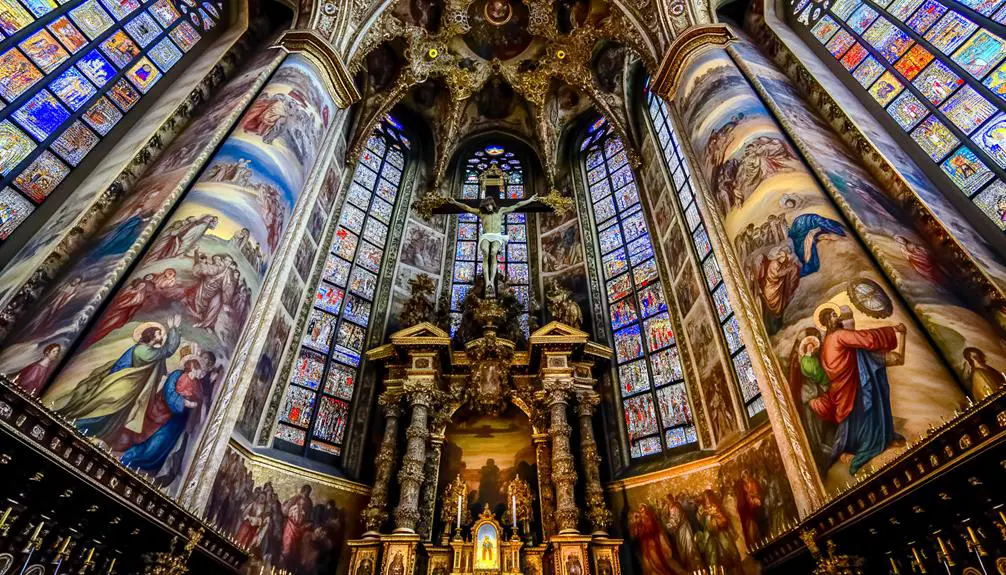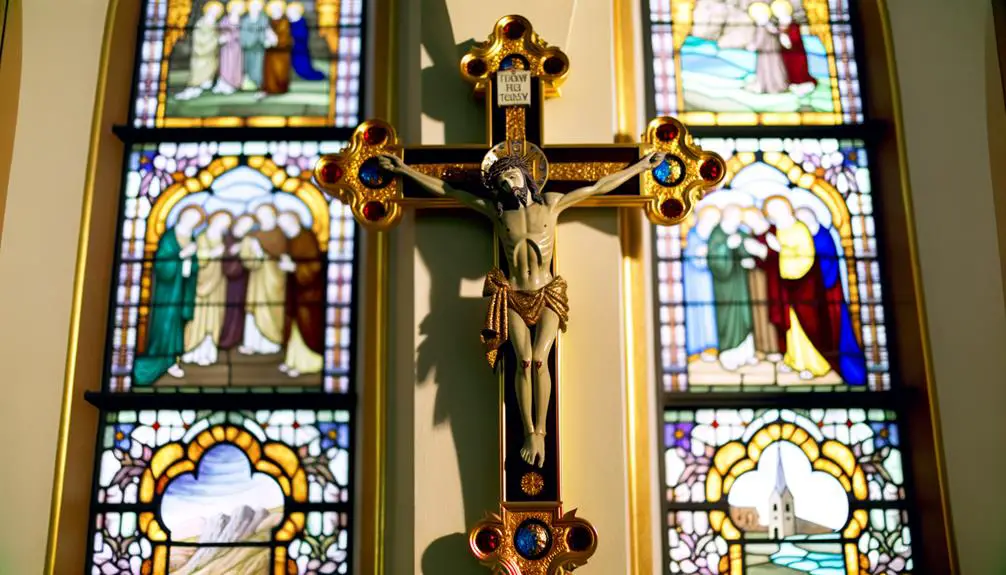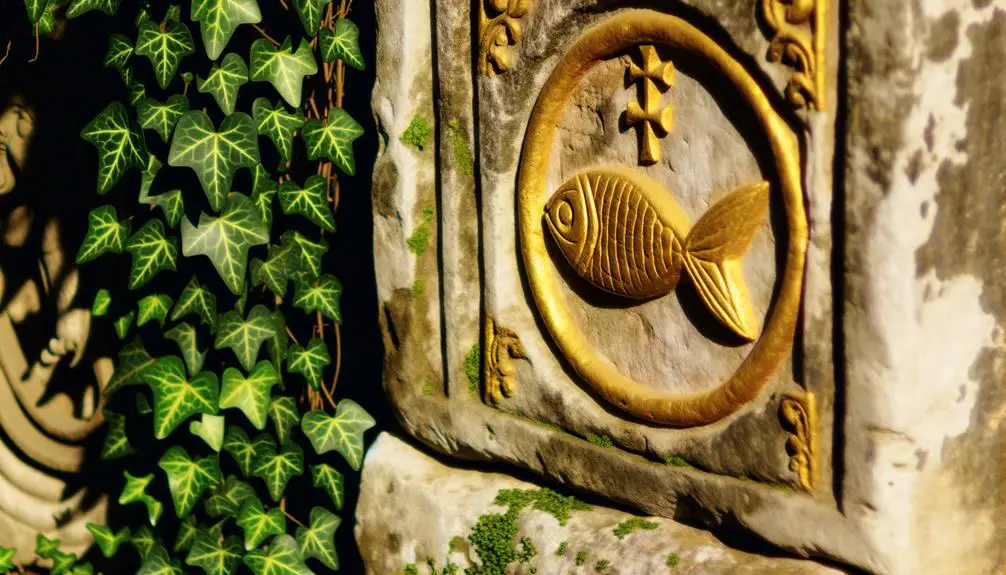Meaning of Symbols in the Catholic Church
The Crucifix, symbolizing Christ's sacrificial death and redemptive atonement, stands as a central icon in Catholic theology. The Rosary, essential for meditative prayer and spiritual reflection, structures devotion into contemplative mysteries.
The Sacred Heart evokes divine love and compassion, emphasizing personal holiness. The Chi-Rho, an ancient Christogram, represents the continuity of faith from early Christianity.
The Ichthys, or fish symbol, underscores Christ's mission and the early Christians' resilience. Collectively, these symbols encapsulate the doctrinal and spiritual essence of the Catholic faith, inviting deeper exploration into their profound meanings.

Key Takeaways
- The Crucifix signifies Christ's sacrificial death and is central to Catholic theology and worship.
- The Rosary aids in meditative prayer and contemplation, fostering spiritual reflection on the mysteries of faith.
- The Sacred Heart symbolizes divine love and compassion, focusing on Jesus Christ's physical heart.
- The Chi-Rho is an ancient Christogram used since Emperor Constantine, representing Christ's name.
- The Ichthys, or fish symbol, historically used during Roman persecution, represents Jesus Christ as the Savior.
The Crucifix

Among the most recognizable and profound symbols of the Catholic Church, the crucifix stands as a poignant representation of Christ's sacrificial death and a central element of Catholic devotion and liturgy.
The crucifix, featuring the corpus (body) of Christ affixed to a cross, serves as a visual theology of redemption and atonement. It underscores the Church's teachings on the Passion, emphasizing both the suffering and the love of Christ for humanity.
Displayed prominently in churches, homes, and worn as personal adornment, the crucifix is a constant reminder of the core Christian belief in Jesus' redemptive sacrifice. Its presence in liturgical practices, such as the Mass, reinforces its doctrinal significance, inviting the faithful to meditate on the mysteries of faith and salvation.
The Rosary
The Rosary, a cornerstone of Catholic devotion, serves as both a meditative prayer and a tool for contemplating the significant events in the lives of Jesus Christ and the Virgin Mary.
This sacred practice involves the repetition of prayers such as the Hail Mary, Our Father, and the Glory Be, structured into five decades. Each decade is dedicated to a specific mystery, categorized into the Joyful, Sorrowful, Glorious, and Luminous Mysteries.
The doctrinal purpose of the Rosary is to foster spiritual reflection, encouraging the faithful to internalize the virtues exemplified by Christ and Mary. Additionally, it acts as a conduit for grace, reinforcing the theological virtues of faith, hope, and charity, enriching the spiritual life of the believer.
The Sacred Heart

While the Rosary encapsulates meditative prayer through its structured sequences, the veneration of the Sacred Heart represents a profound symbol of divine love and compassion within Catholic theology. This devotion focuses on the physical heart of Jesus Christ as an emblem of his immense love for humanity.
Rooted in biblical tradition, it gained prominence through the revelations to Saint Margaret Mary Alacoque in the 17th century. The Sacred Heart is often depicted surrounded by thorns, symbolizing suffering, and flames, representing transformative love. Theologically, it underscores the incarnate love of God and calls the faithful to imitate Christ's compassion and self-sacrifice.
This devotion fosters a deeper understanding of Christ's emotional and spiritual suffering, implicating a call to personal holiness and charity.
The Chi-Rho
The Chi-Rho, an ancient Christogram formed by superimposing the first two letters of the Greek word for Christ, serves as a prominent symbol in early Christian iconography.
Its adoption by Emperor Constantine after the Battle of the Milvian Bridge greatly influenced its spread throughout the Roman Empire and subsequent Christian practice.
Today, the Chi-Rho continues to hold a revered place in the modern Church, symbolizing the profound intersection of faith and historical legacy.
Early Christian Symbolism
Among the earliest and most revered symbols in Christianity, the Chi-Rho epitomizes the profound theological and historical significance embedded in early Christian iconography.
Comprised of the superimposed Greek letters 'Chi' (Χ) and 'Rho' (Ρ), this symbol forms the initial two letters of the Greek word 'Χριστός' (Christos), meaning Christ. Its adoption by early Christians not only signified allegiance to Christ but also served as a covert identifier during periods of persecution.
Theologically, the Chi-Rho represents the intersection of divine and human domains, encapsulated in the person of Jesus Christ. This potent emblem underscores the nascent Christian community's commitment to Christological doctrines, fostering a cohesive identity amid adversity and laying foundational elements for ecclesiastical symbolism.
Emperor Constantine's Influence
Under Emperor Constantine's reign, the Chi-Rho symbol gained unprecedented prominence and became a pivotal emblem of Christian imperial authority. This emblem, formed by superimposing the first two letters of 'Christ' in Greek, epitomized Constantine's acceptance and promotion of Christianity.
The significance of the Chi-Rho can be analyzed through several key developments:
- Constantine's Vision: According to historical accounts, Constantine reportedly had a vision of the Chi-Rho before the Battle of Milvian Bridge.
- Labarum Standard: The symbol was prominently displayed on the military standard known as the Labarum.
- Edict of Milan: The subsequent legalization of Christianity in 313 AD.
- Imperial Patronage: Constantine's support facilitated widespread adoption throughout the Roman Empire.
Collectively, these factors cemented the Chi-Rho as a cornerstone of Christian identity.
Modern Church Usage
Embracing its ancient heritage, the modern Catholic Church continues to utilize the Chi-Rho as a profound symbol of faith, authority, and continuity with early Christian traditions.
This monogram, formed by superimposing the Greek letters Chi (Χ) and Rho (Ρ), represents Christ and serves as a visual proof to the Church's apostolic foundation.
Its usage today spans liturgical vestments, ecclesiastical architecture, and sacred art, thereby reaffirming the Church's doctrinal continuity.
In liturgical contexts, the Chi-Rho often adorns altars and ceremonial objects, embodying the presence of Christ in the Eucharist.
The Ichthys

The Ichthys, an ancient symbol consisting of two intersecting arcs resembling the profile of a fish, has profound theological significance within the Catholic Church, serving as a clandestine sign of faith during periods of persecution and as a representation of Christ Himself. This emblem, rooted in early Christian iconography, encapsulates multifaceted doctrinal meanings:
- Acronym: The Greek word 'Ichthys' (ΙΧΘΥΣ) stands for 'Jesus Christ, Son of God, Savior.'
- Secrecy: Used by early Christians to secretly identify each other during Roman persecution.
- Symbolism: Represents Christ's call to be 'fishers of men' (Matthew 4:19).
- Continuity: Demonstrates the unbroken tradition of faith from ancient to modern times.
Through these elements, the Ichthys remains a potent symbol of enduring faith and doctrinal continuity.
The Papal Tiara
Historically emblematic of the papal office, the Papal Tiara symbolizes the temporal and spiritual authority vested in the Pope. Traditionally composed of three crowns, it signifies the Pope's role as the spiritual leader of the Catholic Church, the governor of the Vatican City, and the supreme pastor of the global Catholic community.
The triple crown also represents the threefold powers: teaching, sanctifying, and governing. Although Pope Paul VI was the last to be crowned with the tiara in 1963, its symbolism persists. The tiara is now primarily a heraldic emblem, featured in the papal coat of arms.
Its enduring legacy underscores the profound historical and doctrinal significance of the papal office within the Catholic Church.
Conclusion
The symbols of the Catholic Church, including the Crucifix, the Rosary, the Sacred Heart, the Chi-Rho, the Ichthys, and the Papal Tiara, each convey profound theological and historical significance.
One interesting statistic is that over 1.3 billion people globally identify as Catholic, illustrating the vast reach and influence of these symbols.
These emblems serve not only as focal points of devotion but also as unifying elements within the diverse global Catholic community, encapsulating the faith's doctrinal and cultural heritage.






